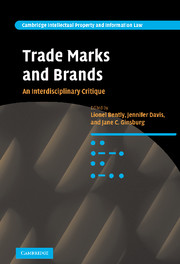Book contents
- Frontmatter
- Contents
- List of figures and tables
- Notes on the contributors
- Editors' preface
- Table of cases
- Table of statutes
- Part I Legal and economic history
- Part II Current positive law in the EU and the USA
- Part III Linguistics
- 5 ‘How can I tell the trade mark on a piece of gingerbread from all the other marks on it?’ Naming and meaning in verbal trade mark signs
- 6 What linguistics can do for trademark law
- Part IV Marketing
- Part V Sociology
- Part VI Law and Economics
- Part VII Philosophy
- Part VIII Anthropology
- Part IX Geography
- Bibliography
- Index
- Titles in the series
5 - ‘How can I tell the trade mark on a piece of gingerbread from all the other marks on it?’ Naming and meaning in verbal trade mark signs
Published online by Cambridge University Press: 13 April 2010
- Frontmatter
- Contents
- List of figures and tables
- Notes on the contributors
- Editors' preface
- Table of cases
- Table of statutes
- Part I Legal and economic history
- Part II Current positive law in the EU and the USA
- Part III Linguistics
- 5 ‘How can I tell the trade mark on a piece of gingerbread from all the other marks on it?’ Naming and meaning in verbal trade mark signs
- 6 What linguistics can do for trademark law
- Part IV Marketing
- Part V Sociology
- Part VI Law and Economics
- Part VII Philosophy
- Part VIII Anthropology
- Part IX Geography
- Bibliography
- Index
- Titles in the series
Summary
Introduction
The law of trade marks has evolved, in different jurisdictions, by addressing two interconnected sets of questions. The first set consists of questions regarding the degree of protection against confusion and deception that should be offered to consumers and traders, over and above traditional passing-off arrangements, in cases where names are used as trade badges or signatures of commercial personae. The second set, less prominent in the literature, are more abstract questions about how names and descriptions achieve their functions of denoting and referring to things in the world. Current legal argument is concerned to find a satisfactory route through these two, intertwined sets of difficulties. This chapter argues that the question voiced in no-nonsense Victorian fashion in my title (which, as Lionel Bently shows elsewhere in this volume, encapsulates a developing nineteenth-century concern with precisely what it is about a sign that allows it to function as a trade mark) resists a definitive answer as much now as during the Victorian period, and continues to have legal significance.
Understandably in legal studies the main emphasis in relation to these two questions falls on how signs function as badges of origin in changing markets, rather than how signs function in principle. In this chapter, in a way that I intend to be complementary, I consider questions about trade mark signification from a broadly linguistic rather than legal perspective.
- Type
- Chapter
- Information
- Trade Marks and BrandsAn Interdisciplinary Critique, pp. 107 - 139Publisher: Cambridge University PressPrint publication year: 2008
- 5
- Cited by



